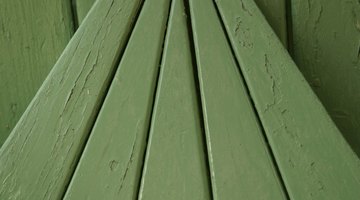What Is the Difference Between Solid Color Deck Stain & Paint?
Solid color deck stain and paint exhibit differences in appearance and weathering characteristics. Learning the difference between these popular deck finishes and their advantages and disadvantages allows you to choose the right finish for your outdoor structure.

Composition
Solid color deck stain and paint contain similar compounds in different quantities. Stain contains significantly less pigment than paint. Pigment not only adds color to wood finishing product, but also blocks lights and prevents a wood deck from weathering. Both deck paints and deck stains are available as oil-based and latex-based mixtures. While traditional, penetrating wood stains soak into lumber, solid color deck stains contain solids that cause the stain to form a permanent film on the lumber's surface, similar to paint.
Appearance
Although solid color deck stains form a paint-like film over lumber, the coating remains thin and allows a vague view of the wood's surface appearance. Alternatively, deck paints contain substantial pigment and create a flat "shell" over deck lumber that completely conceals the underlying lumber's character. Mixed to specification by home improvement stores and paint suppliers, both deck paint and stain are available in a wide variety of colors.
Weathering Characteristics
Paints generally provide more protection to underlying deck lumber than solid color stains. Compared to solid color stains, paints are thick and create a more effective barrier to light, dirt and moisture. However, both paint and solid color stain eventually crack or blister after prolonged exposure to sunlight and inclement weather.
Application and Refinishing
Deck paint and solid color stain have similar application and refinishing requirements. Builders apply both deck finishes with sprayers, rollers and brushes. Additionally, both coatings perform best when applied over a coat of primer. However, because solid color stain is intrinsically "thinner" than deck paint, it tends to require more frequent refinishing than deck paint. To refinish deck paints and solid color stains, builders strip and sand the weathered deck surfaces and apply a fresh coat of either paint or stain.
The Drip Cap
- Solid color deck stain and paint exhibit differences in appearance and weathering characteristics.
- Solid color deck stain and paint contain similar compounds in different quantities.
- Although solid color deck stains form a paint-like film over lumber, the coating remains thin and allows a vague view of the wood's surface appearance.
- Builders apply both deck finishes with sprayers, rollers and brushes.
References
Writer Bio
Based in Hawaii, Shane Grey began writing professionally in 2004. He draws on his construction experience to write instructional home and garden articles. In addition to freelance work, Grey has held a position as an in-house copywriter for an online retailer. He holds a Bachelor of Arts in theater arts from Humboldt State University.
Photo Credits
- Hemera Technologies/AbleStock.com/Getty Images
- Hemera Technologies/AbleStock.com/Getty Images
More Articles



